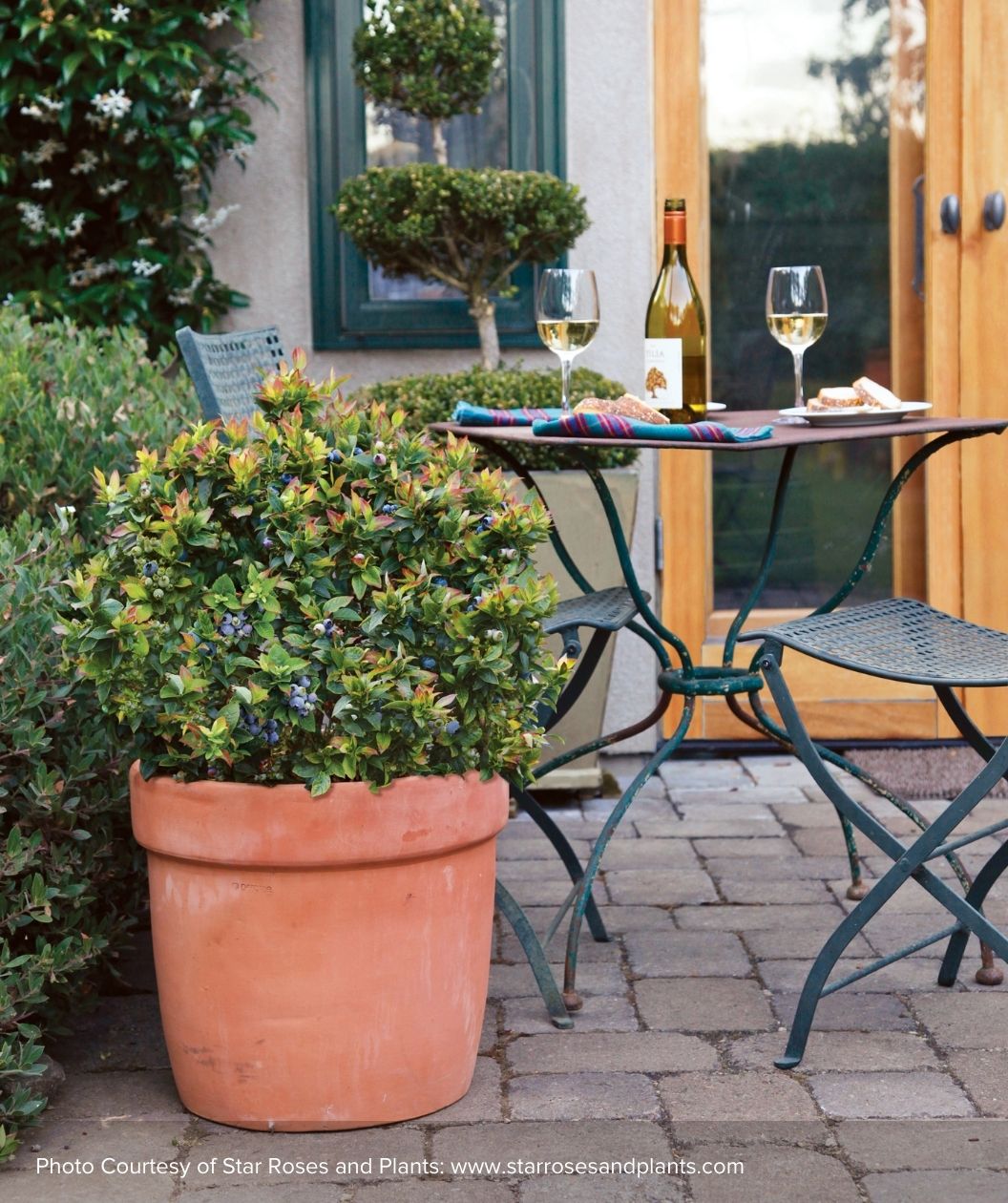




A cheerful, compact blueberry that brings candy-sweet fruit and glowing foliage to patios, borders, and gardens of every size
FEATURES:
- Sold in bundles
- Produces sweet, rich blueberries with dessert-like flavor
- Naturally compact and rounded for small spaces and containers
- Self-pollinating and easy to grow
- Bright green summer foliage turns red-orange in fall
- Covered in white spring blossoms that attract pollinators
- Low-maintenance and ornamental year-round
- Ships on our trucks because of the size of the plant; does not fit in a box
Bower & Branch Landscape Design Tip
Plant Jelly Bean® in full sun with well-drained, acidic soil for the sweetest berries and most vibrant foliage. When growing in containers, use a mix made for acid-loving plants such as azaleas or rhododendrons. Water regularly to keep the soil evenly moist but not soggy. Prune lightly in late winter or early spring to shape the plant and remove older branches. Because it is self-pollinating, you only need one plant for fruit, but multiple Jelly Bean® shrubs will increase your yield and add lush texture to your garden.
Photo Credit: ©Star Roses and Plants® Jelly Bean Blueberry
Growth Facts
- Hardiness Zone: 4-8
- Mature Height: 1-2' tall
- Mature Width: 1-2' wide
- Exposure: Full Sun
- Spacing: 1-2' apart
A cheerful, compact blueberry that brings candy-sweet fruit and glowing foliage to patios, borders, and gardens of every size
FEATURES:
- Sold in bundles
- Produces sweet, rich blueberries with dessert-like flavor
- Naturally compact and rounded for small spaces and containers
- Self-pollinating and easy to grow
- Bright green summer foliage turns red-orange in fall
- Covered in white spring blossoms that attract pollinators
- Low-maintenance and ornamental year-round
- Ships on our trucks because of the size of the plant; does not fit in a box
Bower & Branch Landscape Design Tip
Plant Jelly Bean® in full sun with well-drained, acidic soil for the sweetest berries and most vibrant foliage. When growing in containers, use a mix made for acid-loving plants such as azaleas or rhododendrons. Water regularly to keep the soil evenly moist but not soggy. Prune lightly in late winter or early spring to shape the plant and remove older branches. Because it is self-pollinating, you only need one plant for fruit, but multiple Jelly Bean® shrubs will increase your yield and add lush texture to your garden.
Photo Credit: ©Star Roses and Plants® Jelly Bean Blueberry
Growth Facts
- Hardiness Zone: 4-8
- Mature Height: 1-2' tall
- Mature Width: 1-2' wide
- Exposure: Full Sun
- Spacing: 1-2' apart
Why plant Jelly Bean® Blueberry?
A jelly belly full of blueberries! In July, enjoy masses of blooming berries on this compact shrub, perfectly sized for a patio container on your summer deck or in garden beds. This low maintenance plant features dainty white bell flowers in mid-spring, adding a touch of pink for a sunkissed glow - bursting into an abundance of berries for its dwarf size, and a sweetness like handfuls of jelly beans! When autumn comes around, and all berries have been enjoyed, the glossy foliage gives way to an outstanding crimson red color. Bushel and Berry® Jelly Bean® Blueberry may be small but is packed full of beauty and deliciousness!
How to use Jelly Bean® Blueberry in the landscape?
Blueberries have never tasted so good! Jelly Bean blueberries are like snacking on fresh, homemade blueberry jelly just in fruit form. A very yummy fruit that you'll want to plant everywhere! The foliage is just as unique as the berries, as the leaves are elongated and deep green. Cooler climates may see lines of reds highlighting the leaves as well. A great addition as a hedge, or lining a border, this blueberry will good great anywhere without being unsightly.
Planting Zones
Hardiness Zone: 4-8
How To Plant Jelly Bean® Blueberry
Acid soil is key to growing Blueberries successfully. These peat-loving Accents require very low–pH conditions in order to thrive. If your soil isn’t naturally acidic, you may want to grow Jelly Bean Blueberry in a large container or raised bed. Give it all-day sun if possible and use lots of organic matter—both as a soil amendment and as mulch.
How To Water
Water twice weekly for the first 3-5 weeks; then water weekly for the remainder of the year until winter. When you water, water very slowly and very thoroughly. The water needs to reach to the bottom of the root ball and that takes time. Watering needs may be altered due to extreme weather conditions.
How To Prune
As your Blueberry matures, you should thin your plant by about 1/3 by removing the older canes - this will allow new branches to fruit the following year.
Frequently Asked Questions
Yes. Jelly Bean® is perfect for container gardening. It thrives in large pots filled with acidic soil and enjoys full sun for maximum fruit and color.
Jelly Bean® produces fruit in midsummer. Its berries are rich, sweet, and perfect for fresh eating, baking, or adding to breakfast bowls.
Yes. Jelly Bean® is self-pollinating, though planting it near another blueberry variety may increase yields and fruit size.




